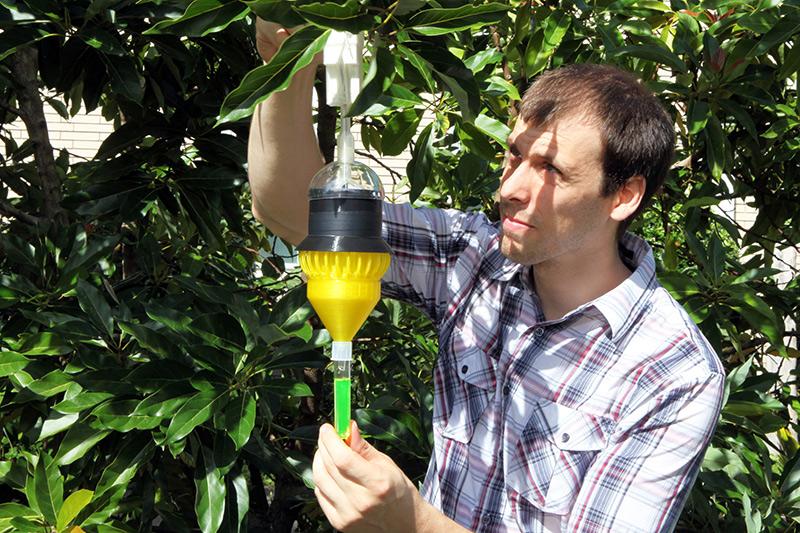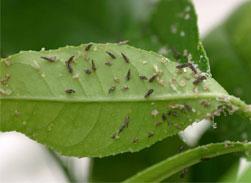Florida has a big problem with small bugs, but 3D printing may be the state’s unexpected and simple solution to fighting the tiny tyrants called Asian citrus psyllids. This particular insect ccan transmit disease or parasites from one animal or organism, spreading citrus greening disease through Florida’s orange groves. Over a five-year period, the Florida farming industry lost $4.5 billion in output and was forced to cut 8,000 jobs because of the effects of the psyllid on the citrus crop. Another psyllid that attacks potatoes and tomatoes has also been detected on some Florida farms, although it has not caused a widespread infestation… yet.
State inspectors install trap lines on Florida farms and in orchards to monitor insects. The most commonly used psyllid traps incorporate a glue known as “tanglefoot.” The problem with the glue traps is that inspectors need to be able to remove intact insects for studies but the specimens are frequently damaged, which prevents scientists from doing helpful genetic or molecular work.

Technician Tony Dickens holds up a part of the 3D printed trap. Photo courtesy Joshua Reid Carswell, FDACS.
One of the other drawbacks of the sticky traps is that the glue does not contain a preservative, so the insects decay quickly. That means that inspectors need to check the traps almost constantly, a nearly impossible feat.
Enter 3D printing. Scientist Trevor Smith and his team at the Florida Department of Agriculture and Consumer Services’ (FDACS) 3D printing project have been experimenting with 3D printed insect traps that appear to work better because the insects end up in a small reservoir in the trap  containing preservative. They can usually be recovered intact from the 3D traps, which is a major victory for the scientists who need to study the psyllids and the diseases they spread to valuable crops.
containing preservative. They can usually be recovered intact from the 3D traps, which is a major victory for the scientists who need to study the psyllids and the diseases they spread to valuable crops.
The 3D printing project is co-funded by the state of Florida and the United States Department of Agriculture (USDA). Cost is fairly minimal — the printer was $2,300 and each trap costs about $5 to $10 to print. Right now, the team of four researchers is relying on a single 3D printer but they plan to buy a larger printer in the next month or so.
The team is experimenting with different trap designs, which are printed and tested in their lab as well as at the Florida Citrus Arboretum located in Winter Haven, Florida. The traps need to attract the insects and make it impossible for them to leave once inside. The research team is currently trying to figure out how to manipulate the colors and shape of the traps and to incorporate light and chemicals, all of which can attract the insects. Yellow seems to be the most appealing color for the psyllids. As far as light is concerned, the insects tend to crawl toward light so the researchers are using LED lights in their 3D printed trap designs.

Technician Tony Dickens attaches a 3D insect trap onto a tree. Photo courtesy Joshua Reid Carswell, FDACS
“Once you know the target pest’s behavior, then you can tailor the trap to the insect,” said Smith. “It’s half art, half biology.”
Smith and his research team expect to have results from their pilot tests of the 3D-printed traps will be available within the next three or four months. After finalizing the design for the psyllid trap, the team in Florida will move on to tackle other minute but mighty invaders.
Let us know your thoughts on this use for 3D printing in the 3D Printed Insect Traps forum thread over at 3DPB.com.
Subscribe to Our Email Newsletter
Stay up-to-date on all the latest news from the 3D printing industry and receive information and offers from third party vendors.
Print Services
Upload your 3D Models and get them printed quickly and efficiently.
You May Also Like
Consolidation in AM: How 2025 Is Shaping the Industry’s New Normal
The first half of 2025 has been marked by a clear shift in the additive manufacturing (AM) industry. Companies are no longer just focused on developing new tech by themselves....
Etsy Design Rule Change Reduces Selection of 3D Printed Goods
Online marketplace Etsy has implemented a rule change requiring all 3D printed goods on the site to be original designs. The update to the site’s Creativity Standards states, ¨Items produced using...
U.S. Congress Calls Out 3D Printing in Proposal for Commercial Reserve Manufacturing Network
Last week, the U.S. House of Representatives’ Appropriations Committee moved the FY 2026 defense bill forward to the House floor. Included in the legislation is a $131 million proposal for...
Transforming From Tourist to Native: Duro CEO Michael Corr Explains Why the Company Rebuilt its PLM Software on AI
In these early innings of the AI boom, many market analysts have expressed concern that AI spend has gotten too far ahead of the technology’s proven ability to deliver significant...

































